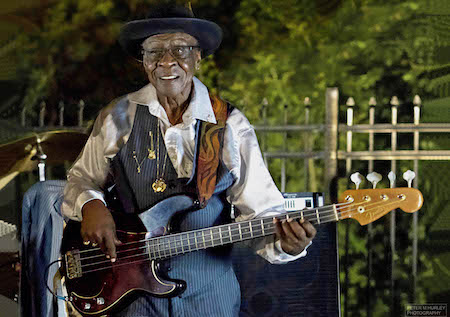Oct 28, 2025 10:47 AM
In Memoriam: Jack DeJohnette, 1942–2025
Jack DeJohnette, a bold and resourceful drummer and NEA Jazz Master who forged a unique vocabulary on the kit over his…

“People gave me so much in this business, I just want to give something back,” Bob Stroger said about playing with younger musicians.
(Photo: Peter Hurley)Just before the COVID pandemic, bassist Bob Stroger’s touring itinerary took him around the world. He also recorded the recently released That’s My Name (Delmark) with his Brazilian blues band, The Headcutters, near their country’s southeast coast. Now that venues are re-opening, Stroger has picked back up where he left off. At 91, he sees no reason to slow down.
“As long as I satisfy my fans, I’ll keep going,” Stroger said from his home on Chicago’s South Side. “I never think about retiring from music. When you retire, if you have the money, you travel. So I’m retired now because I travel around the world doing this.”
That’s My Name encapsulates Stroger’s wide and lengthy experiences. His compositions, especially the title track, showcase his amiably spacious bass lines and expertise in this music’s history. He embraces material by artists ranging from early blues singer Ma Rainey to jazz bandleader Jay McShann. He also revisits pieces that some of his former colleagues wrote, including Eddie Taylor. Such versatility has always been crucial for his work.
“My style changed when I played with Otis Rush, then when I played with Eddie Taylor,” Stroger said. “Then when I played with Snooky Pryor I changed styles again. I had to listen and find styles that fit their playing. With this CD, I didn’t want all the songs to sound the same. So I played all of my heroes.”
The album also highlights Stroger’s quietly compelling voice. Still, he remains humble about his subtle delivery’s emotional impact.
“I’m my biggest critic, I just sing my personality,” Stroger said. “A lot of good singers can sing like different people, but I can’t. I sing the way I talk. I’m a country boy, and it shows in the way I’m singing.”
That country boyhood was spent in Hayti, Missouri. As a young adult, Stroger moved to Chicago, where his father worked for a railroad and, fortuitously, they lived near a hotbed of the city’s thriving West Side blues scene.
“When I was living on Oakley Avenue, Silvio’s was on Lake Street,” Stroger said. “I could walk out my back door and look in the window of Silvio’s and I saw Muddy Waters, Hubert Sumlin, Howlin’ Wolf. I saw all the big guys. I never had a suit and they were wearing suits and ties and I said, ‘I really want to do that.’ When I was in the country cotton fields, we didn’t have the college education, and music was the only thing I could do to get recognized. So I went that route.”
Stroger also developed his technique across different idioms. He played in R&B groups and with jazz saxophonist Rufus Forman before becoming blues guitarist Eddie King’s bassist throughout the 1960s. These encounters continue to shape Stroger’s sound.
“A lot of people said I was a smooth bass player because I play a lot of chromatic notes,” Stroger said. “And that’s kind of smoothing it out, that’s where my style comes from. I think it comes from picking up the jazz notes and some of the stuff you do on upright bass.”
Bandleaders Otis Rush and Sunnyland Slim admired that approach and included Stroger in their ensembles as more global festivals began to feature blues artists during the 1970s and 1980s. Gradually, he started releasing records under his own name, starting with In This House: Live At Lucerne, Vol. 1 (Crosscut) in 2002. Nowdays, his main inspiration for recording is to spotlight his international collaborators, primarily The Headcutters. DB

Jack DeJohnette boasted a musical resume that was as long as it was fearsome.
Oct 28, 2025 10:47 AM
Jack DeJohnette, a bold and resourceful drummer and NEA Jazz Master who forged a unique vocabulary on the kit over his…

D’Angelo achieved commercial and critical success experimenting with a fusion of jazz, funk, soul, R&B and hip-hop.
Oct 14, 2025 1:47 PM
D’Angelo, a Grammy-winning R&B and neo-soul singer, guitarist and pianist who exerted a profound influence on 21st…

To see the complete list of nominations for the 2026 Grammy Awards, go to grammy.com.
Nov 11, 2025 12:35 PM
The nominations for the 2026 Grammy Awards are in, with plenty to smile about for the worlds of jazz, blues and beyond.…

Drummond was cherished by generations of mainstream jazz listeners and bandleaders for his authoritative tonal presence, a defining quality of his style most apparent when he played his instrument unamplified.
Nov 4, 2025 11:39 AM
Ray Drummond, a first-call bassist who appeared on hundreds of albums as a sideman for some of the top names in jazz…

Jim McNeely’s singular body of work had a profound and lasting influence on many of today’s top jazz composers in the U.S. and in Europe.
Oct 7, 2025 3:40 PM
Pianist Jim McNeely, one of the most distinguished large ensemble jazz composers of his generation, died Sept. 26 at…






